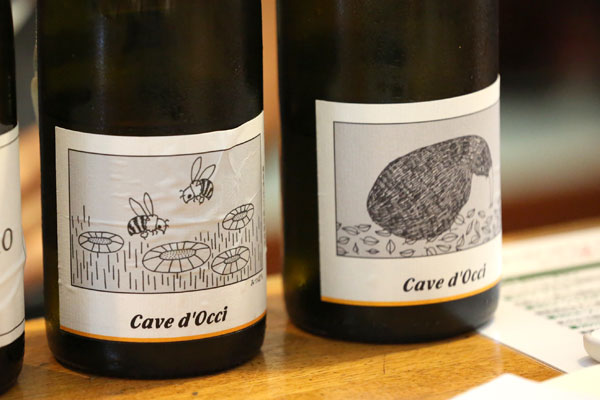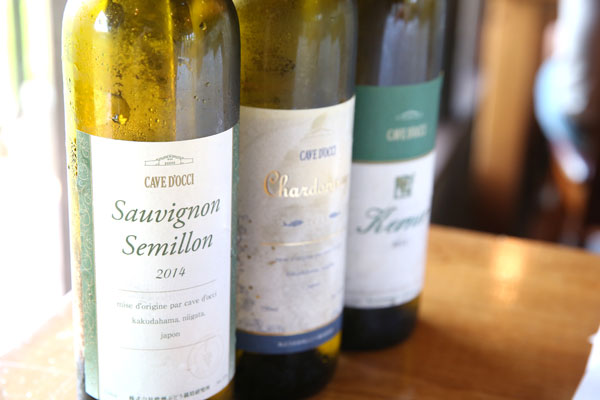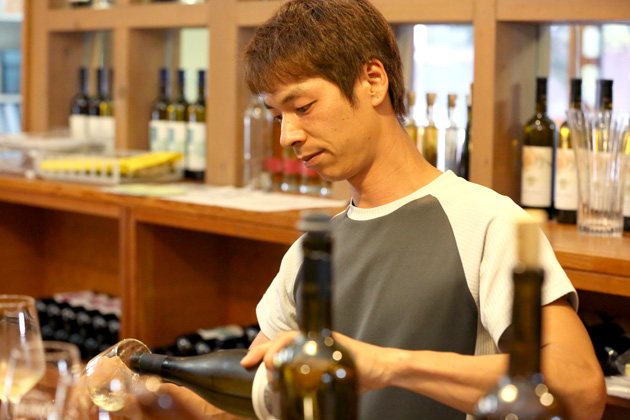
Interview with Chief Winemaker Mr. Fumito Kakegawa of CAVEDOCCI
JAPANTWO(JP2):Please tell us how you became a winemaker.
Winemaker Mr. Fumito Kakegawa(Mr. Kakegawa):Originally, I wanted to become a farmer. When I was young, we had this thing called "compost" in our back yard; it composted garbage by sprinkling limestone. One day I went to chuck the garbage there and saw a vine growing out of the compost, and it had a pumpkin growing on the end. I was amazed by the fact that there was food growing out of the garbage so I thought, "I want to grow vegetables!." When I was in the third grade, I modified my garden into a farm and grew a lot of vegetables in planters on the veranda. Soon, my mom started to open a winery when I was in first year middle school and she asked me, "Do you want to start a winery with me? Wine is made from grapes and you like agriculture, don't you? I said, "Yup, I'll do it," and became a winemaker. Things turned out smoothly since I had my childhood dream of becoming a farmer.
JP2:Where did you study to become a winemaker?
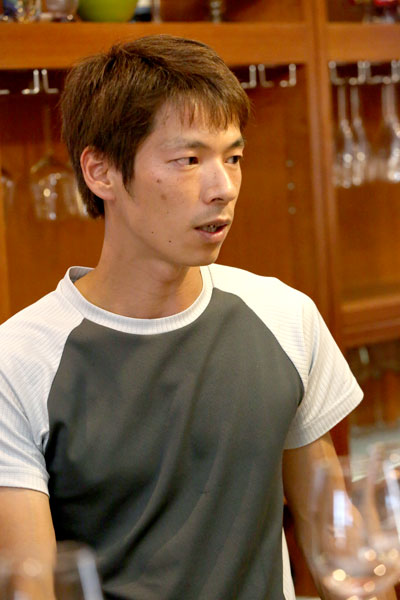
Mr. Kakegawa:I studied at a wine school in France for 2 years. Aside from that, I went to the Domaine in Burgundy as a trainee and worked in the farm and the distillery with the people. However, I couldn't speak much French, and when they explained things to me I couldn't understand much due to the technical terminology, so it was more like "I watched and learned" in my case. Unfortuantely, the knowledge I've gained in France about cultivation was useless. Again, their method works in their land, so it was like when I came back to Japan I studied on my own and learned while actually doing it myself.
JP2:What is the most enjoyable thing about wine-making?
Mr. Kakegawa:I enjoy when I'm touching the yeast or things that are fermenting. In the case of red wine, the skin and seeds are fermented together and you can see them from the top of the open tank. It starts bubbling, and you get all kinds of smell and reactions and you witness the change, realizing the ideas you have in your mind. When the wine is made, the only thing you can do is to drink and enjoy it. But during the fermentation process, I begin imagining things and prepare the wine by adjusting the things that can be changed. The best part is to approach the fermented thing and see the process of wine being made. When it turns out exactly like I imagined, it feels awesome and I'm happy when the wine tastes good.
JP2:On the other hand, what's something that is difficult?
Mr. Kakegawa:I think the weather. It's not exactly a difficult thing, but I have no control over it; it's more like, "I can't have it my way." Rain is the worst, so I have a hard time when it rains for a long period.
JP2:What is something you always keep in mind when making wine?
Mr. Kakegawa:It's "to satisfy all the basic elements of the product." For example, it needs to be safe. Since it's something that enters people's mouths, the least I can do is to make it safe for consumption. Wine-making requires a lot of microorganisms, and in certain cases they produce allergens. Antioxidants is an allergen, and if we don't use it, another type of allergen will be produced. On one hand, I want to avoid the production of any substance that is recognized as "bad for the body," as much as possible. On the other hand, I cannot avoid using them unless it's a special type of wine. So, with respect to wine that require some degree of stability, I don't use reckless amount of antioxidants, but I make sure to just use the minimum amount required.
In addition, Japan's wine industry, which has few restrictions concerning brewing and manufacturing of wine, has begun to develop and everyone is making various things without much thought and consideration. "Nigori Wine" (cloudy wine) and "Nigori Sparkling Wine" became popular, but there were times when two-third of the liquid would gush out after opening the cork. I don't believe that those things should be sold as a product. In Japan where it's “free-for-all” when it comes to wine, I think keeping the basic standard of "keeping it safe" and "making a respectable product" is the best thing I can do as an individual, and the most important thing that I have to keep in mind. As a food manufacturer, I think it's a basic thing we need to guarantee our consumers, even before guaranteeing the taste of the product.
JP2:What is something you pay the closest attention to when making wine?
Mr. Kakegawa:I try not to hide the quality and distinct characteristics of the grapes. There are the grapes, the producers, and the wine. By the time the grapes become wine, they pass through "the filter," or the person who makes it, and normally they will pick up the person's smell, and his taste. But I want to naturally express the qualities and characteristics of the grapes, which reflect the various conditions of this land, without covering it up with my personal "color" and smell. So I want the grapes to "bypass" me through the process of becoming wine.
JP2:What do you specifically mean by "bypassing me," Mr. Kakegawa?
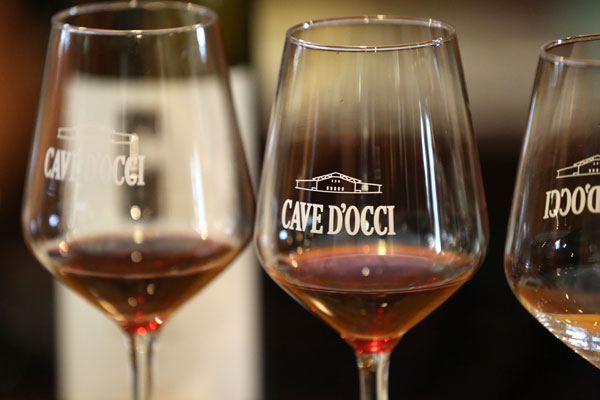
Mr. Kakegawa:It means that I'm not going to force the change in taste by adding or substracting something. For example, some people add sour tastes if the wine lacks sourness. Others use filters for fining (a process to get rid of compounds within the wine), or they may use gelatin or bentonite. When it comes to making wine using chemicals, you can make a thick catalog just by listing the ingredients; there are all types of "magical power" available in the market. I obviously want to make things naturally, but if I start adding and subtracting things, I am actually "expressing my color" in the product and I don't want to do that. Normally, most people would express their color in their product, so I guess I'm quite unique. I just want to draw out the qualities within the particular grape variety.
JP2:Why do you think in that way?
Mr. Kakegawa:"Finding the right grape varieties that suit this land, and making the wine that is unique to this place" is the major proposition we have. We want people to feel, "I look forward to the wine made here. The grapes suit this land and I want to start making wine too." If I were to express my color, the qualities and characteristics of the grapes grown here would disappear. People would end up saying, "All of the varieties taste like Kakegawa's wine." Also, I am not the owner, but one of the producers here, so I am thinking about how the wine should be. Let us say a beginning wine drinker, who doesn't drink often, drinks our Chardonnay. If that Chardonnay had the incredibly strong "color" of mine, and feels that it is delicious, when he drinks another Chardonnay he might feel, "Oh, Chardonnay isn't that tasty." Instead, I would like him to drink Cave d'Occi's Chardonnay and try Chardonnay from another brand and notice the similarity in the fragrance and say, "Chardonnay is quite delcious, after all." Considering all those things, I think it's better to express the characteristics of the variety more than expressing it in your color; we need to make wine that has the common taste but is simply delicious.
JP2:Under such circumstance, what made you decide in making the "Animal Series Wine" which was inspired by your hobby?
Mr. Kakegawa:I was interviewed for a wine magazine 1 - 2 years ago. Personally, I thought I presented them with something that was great, but it ended up with a disappointing result. Moreover, during the same time, a young and newly-hired employee made a brash comment, "Why are you making a thing like this?" Within those few months, I received similar comments from several people. I was quite shocked when I heard those comments and thought to myself, "Maybe I'm getting those comments because I'm not doing what I want to do. If someone were to ask me if I had put in 100% effort, I would answer that there were times when I didn't do so." After reflecting back on my mistake, I decided to think it through once again, study, and pour all my energy into wine-making; I worked hard for one year. Then, I started to get good reviews and people began asking me, "We now know that you can make good wine, but what kind of wine do you want to make or drink yourself?" That's when I thought,"Maybe, this is the moment to make something new," so I made the Animal Series.
JP2:What is your favorite in the Animal Series?
Mr. Kakegawa:My favorite in the Animal Series is "The Bear." It has strong acidity, almost like vinegar. It's a little different and I really like it.
JP2:Do you have any preference when it comes to wine labels?
Mr. Kakegawa:For the Animal Series, I found pictures in my painter friend's sketchbook and I asked him, "Give me these cute drawings." So I got them and made them into labels. The mole was called "Kiwi-style Mole Bird", but it was too long so I got his permission and shortened it to "The Mole". For the badger, he did not recall what he scribbled down for its name so he just named it "The Badger." I asked him to draw the bee label too.
JP2:How about the corks?
Mr. Kakegawa:We are using two types of corks: one is the synthetic cork which is finely crushed and hardened under pressure, the other is the natural cork.
Basically, the synthetic cork is immensely better. There are two problems concerning corks: one is the seal, and the other is about the phenomenon called "bouchoneé," These synthetic corks have never leaked to this day, nor have they experienced bouchoneé (* 1), so they are fabulous. However, since they are too tightly sealed, there is the problem of checking how the content has aged inside the bottle. When it comes to long-term aging, the natural corks are better for some oxygen to enter the bottles. So, we use the natural cork for the aging bottles and the syntehtic corks for the others.
* 1 = the wine getting contaminated with bacteria due to the cork. They smell like mold and often affect the fragrance.
JP2:Do you use domestic corks?
Mr. Kakegawa:When it comes to wine, Japan is still a developing nation and the raw materials for cork has been gradually depleting. That means we need to import them. But the quality materials are taken by Europe, then they go to the United States, Australia, and finally Japan. So the reality is that the domestic corks end up being poor quality. That's why we import corks from Spain. Since we are directly dealing with the Spanish company, a single cork costs a lot. Maybe it costs more than a bottle. Comparing the unit price with labels, caps, seals, and bottles, the corks are probably the most expensive.
The only thing we can do is to fill these bottles with wine; after that things are out of our control. That means we need these corks to do their jobs, and that is why we spend quite a lot of money on them.
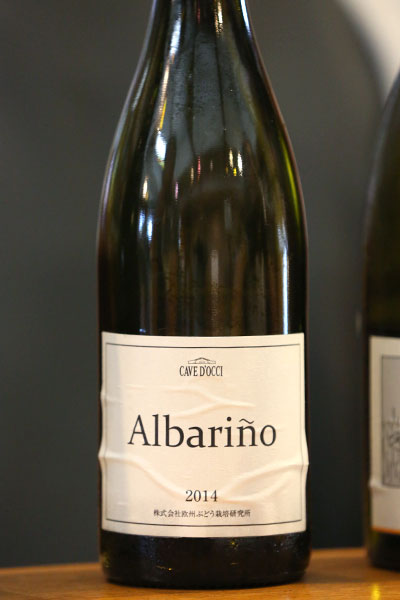
JP2:Which wine is your favorite amongst the ones you have made?
Mr. Kakegawa:Albariño. This is outstanding and I've been recommending it since it was first made. Everybody would love it. If I were to express the grape's quality numerically, it would definitely be excellent! It's great to have a grape variety like that because it becomes a big advantage as a winemaker. We are not the only ones growing them but other wineries around Cave d'Occi do too. This wine region will be recognized if we find the varieties that suit this place and we all make wine out of them. They'll end up tasting good and each wine will be unique. And there will be more people who would start making wine here. That's why I want more people to try Albariño.
JP2:What is something that you work on the most, as a winemaker?
Mr. Kakegawa:Studying. From distillation, cultivation, to pesticides, I've been working really hard every day collecting a lot of information related to my job. A journey of a thousand miles begins with a single step; new machines get developed, and things that we did not know gets discovered. You need to buy machines to use them so I'm not really interested in them but there's a significant difference between knowing and not knowing about new discoveries; that's why I don't procrastinate and always continue studying. I can boast to people how much I study.
JP2:How do you study?
Mr. Kakegawa:On the net. About half of the month, I go to a cafe with my laptop and start studying by searching information on the net. When it comes to academic research, the French and Americans are great; One month after the paper is published, it goes on the net and even I can read it. Since they are written in foreign languages it takes time for me to read them, but it's nice to be well-informed by them. I share the things I searched and learned with the other wineries, so we can all level up as a whole.
JP2:You said that you have a target flavor when making wine. Do you decide that?
Mr. Kakegawa:I discuss it with Number 2 and we decide together. Number 2 who I discuss with is the guy who was insulting our wine the most but, personally, I like a person who says "what's wrong" out loud. We won't imporve just by receiving compliments so each time we talk about "what's wrong" and decide what action to take.
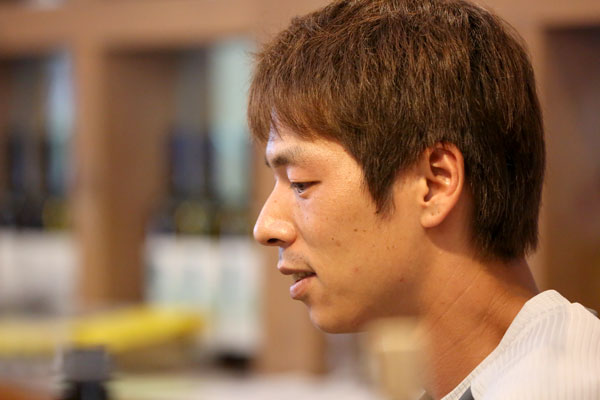
JP2:As a winemaker, what aspect of wine are you attracted to?
Mr. Kakegawa:The aspect that you can drink it after many years. When I drink wine I recall, "That year was a year when I tried such-and-such, and I struggled and had conflicts with so-and-so," remembering myself in that year. Simply, it's my "history." I can, not only recall my old memory at this moment, but I also can drink and enjoy the taste that has changed since it was made. This, I think, is very attracive. Even though we have made well over 200 types of wine, I can recall most of them and their good qualities.
JP2:What is attractive about working as a winemaker?
Mr. Kakegawa:I guess it's how the time passes slowly. You need to wait 10 years after planting the seedlings, so there isn't any point in rushing things, so time flows gently. I like how the time flows. I've never worked at another job so I don't know how other people feel about time, but I imagine that everyone is sprinting short distances and repeating that over and over. For us, we know that it's a long-distance marathon from the get-go, so we can start off slow and we are quite relaxed psychologically.
If it's possible, when I have a kid I want him to join this company, and succeed my business; there aren't many careers that you can recommend to your kids.
If I have to pass this thing, which I had poured my soul into, to someone, a family member will be the best.
JP2:As a winemaker, how would you like your customers to enjoy the wine?
Mr. Kakegawa:As a winemaker, how would you like your customers to enjoy the wine? I'd like them to find out what they like. Wine is the alochol with the widest variety. There are sweet ones, spicy ones, sour ones, not so sour ones, and all kinds of taste so there must be a wine that you would definitely like. If you can find your favorite, I think you will really have a great time. It takes some time getting used to wine, but at first you can just hold your thoughts and try them. Then you will find that wine is actually a fine drink. I hope everyone can come upon their favorite glass of wine.
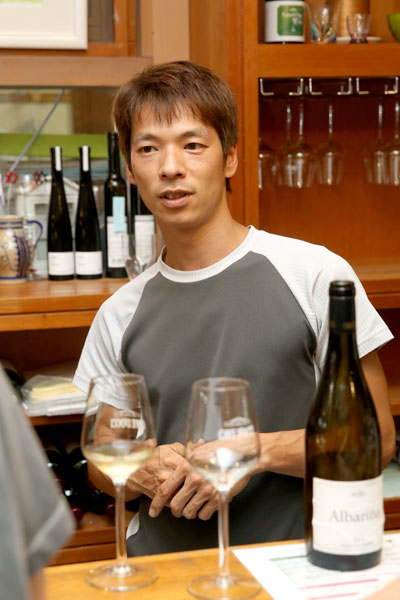
JP2:Do you have a goal or something you'd like to challenge in the future?
Mr. Kakegawa:I want to stop using rootstocks. There are these aphids called "phylloxera," that eat grapvine roots and kill them. One time, these aphids that originally had their habitat in North America were accidently spread in Europe when the Europeans imported American grapes. European grapes were vulnerable to these phylloxeras and suffered a catastrophic damage. As a solution, the Europeans vines were grafted onto the American rootstocks (roots), and now 99.99% of the European varieties cultivated around the world use them; we're also using the rootstocks to grow the grapes. In fact, there are 0.01% of European grape varieties that do not use them, which are grown in sandy soil. Since the phylloxera is uninhabitable in sand, I want to take advantage of this characteristic and start growing European grapes with their "own" European roots, without using the rootstocks. That will be the challenge for this winter and it's the thing I am looking forward to the most.
JP2:So phylloxeras can be found in Japan, right?
Mr. Kakegawa:Right. So basically, we need to use the rootstocks in Japan too. We have been growing grapes on rootstocks here in Kakudahama, but during the winter, the galewind caused by the Sea of Japan's rough waves cause the ground to rising by about 5 centimeters, so majority of the European vines get burried while the roots get exposed. It's been 20 years since we've been growing them in this state, and we haven't any damaged by phylloxeras so we've certified that there aren't any living in this area any longer. From here, I'd like to grow vines without the rootstock for 5 years, and if there aren't any problems I will increase the number. This is something that is possible only in our field, so it'll be exciting if we can do it.
JP2:How do you grow them using their own roots?
Mr. Kakegawa:Since the extended canes become branches, you cut them and stab them in the ground. Then, it will start growing roots and becomes a seedling. When the roost are out, it can grow on its own. From there you grow them to the size of other vines.
JP2:Do you have any future plans for your wines?
Mr. Kakegawa:We want to expand the Animal Series. We'll add 5 - 6 types, and produce about 8,000 in total. Most small-size individual wineries produce roughly 8000 bottles of wine annually, so I want to use that as a yardstick.
JP2:Could you leave a message to the readers?
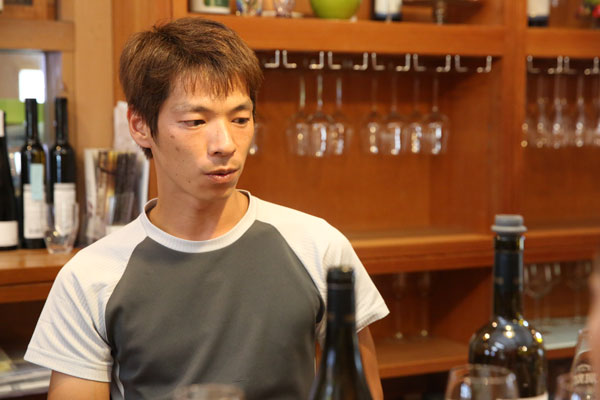
Mr. Kakegawa:Here, we have hard-working people making wine, baking bread, and stuffing sausages, so I hope more people can visit us.You can take a bath, stay over, dine, and enjoy the wine. We have the "luxury of doing nothing" here. Since there is no other place in the wine region that has the all the facilities like us, so I think that you can have a completely new experience here. In addition, there will be around 10 wineries opening so it will be more exciting.
The charm of Cave d'Occi is that the distance between the manufacuters and the consumers is very close: I am here most of the time and you can find other producers at their wineries so you can directly talk to them. By actually talking to people you get really strong connections. There are people who tell me, "I really enjoy coming here once a year." I hope we can "add some color to their lives."
【Mr. Kakegawa's biography】
Fumito Kakegawa
Born on July 19, 1980
1999 Graduates from highschool and moves to France.
2001 Enters CFPPA(Center of professional formation and agricultural promotion) in Beaune, Burgundy.
2002 Graduates from CFPPA
2003 Joins European Grape Cultivation Research Corporation.
2006 Appointed as the chief wine distiller.
2010 Appointed as the company director.
2012 Appointed as the company director of Farm Kakudasan Ltd.
CAVE DOCCI
Homepagehttp://www.docci.com/index.html

